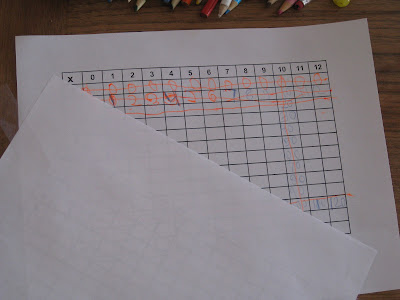The images demonstrate the process for filling in the grid as suggested by Alexandra Shires Golon in her book, Visual-Spatial Learners: Differentiation Strategies for Creating a Successful Classroom. This is also an excellent strategy to use at home. As discussed in an earlier post, VSLs often struggle with the memorization of basic facts as well as with handwriting and number formation.
You will see in the images below some of that struggle in our 2nd grade student. Note for example how he writes the number 4 before the 1 when writing the number '14.' This type of "reversal" is not uncommon. It should be noted that this young man has worked hard through the course of his school year to reduce reversed numbers such as backwards 3's, 4's, 5's and 6's and 9's.
 | |
| Note the '4' written before the '1' in the number '14' |
The process for completing the facts grid should start with a discussion about all that the child already knows. Together this second grader and I discussed all of the facts he knew and he began his chart by filling in the 0', 1's and 10's column.
Note that he chose to use 'guide' lines throughout the grid to keep his columns 'straight.' He has recently had his vision evaluated and was found to have oculomotor dysfunction. That's a 10,000 dollar phrase for problems with eye muscle control and with tracking letters and images on a page. In many cases, vision therapy is prescribed as is the case for this young man.
 |
| A half sheet of blank paper reduces the work load |
In the above image you can see that a sheet of blank paper was used to cover half the grid. This was an opportunity to discuss the commutative property of multiplication. It's also a great way to boost the student into realizing they really only need to learn half the grid!
 |
| a + b = b + a |
In the above example, our 2nd grader and I discussed how a + b = b + a. He pointed out that really the equation should read: a + b = c and b + a = c. Clearly, this student's understanding transcended my explanation.
With enthusiasm, the student continued filling in the chart and moving on to the 5's. Most students learn the 5's early in the primary grades. This boy and I sang the song to the 5's from School House Rock.
 |
| Be sure to point out that all 5 facts end in a 5 or zero! |
In an upcoming post we will explore a few other methods for guiding our friend through developing meaning and visual connections to his process of learning his multiplication facts.
No comments:
Post a Comment